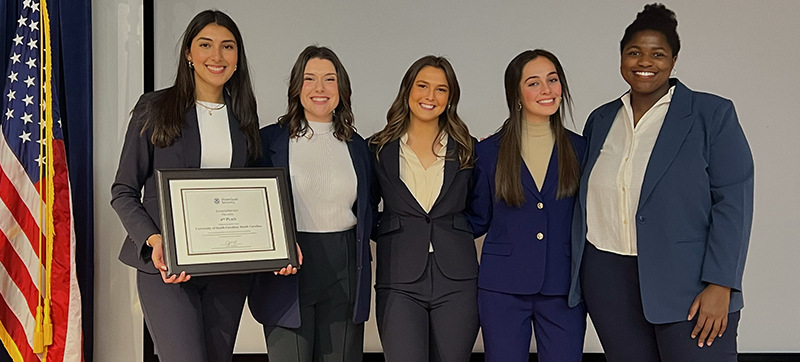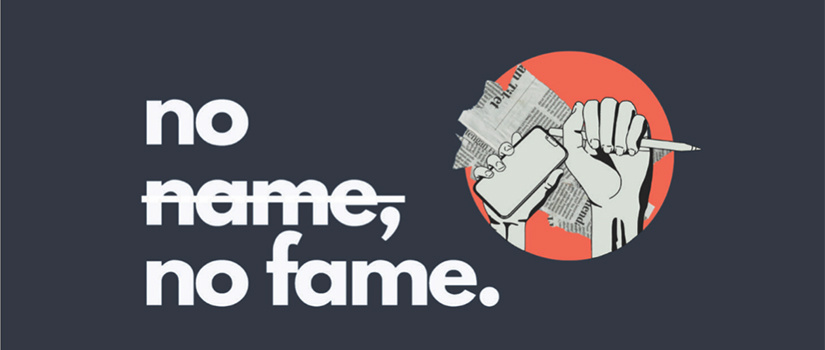Did you hear about that shooting last night?
The question is pretty familiar. It’s nearly ingrained in small talk in America today. The perpetrators of mass shootings are often included in those discussions. When asked how they would prevent targeted violence and terrorism, it occurred to a group of nine students that this pattern in their conversations needed to change.
The students in professor Ernest Grigg’s Public Relations Campaigns class believe that by decreasing the regularity of mentioning shooters in these conversations, mass shootings will become less regular. The team devised a plan to avoid sensationalizing mass shootings through mitigating the media contagion and copycat effects of mass shootings. The plan laid out how to navigate keeping the public informed while removing the name and the fame attached to these all-too-regular news stories. In fall 2022, the campaign titled “no name, no fame.” was created.
The University of South Carolina offers a variety of public relations campaigns courses, including one with an option to take it for two semesters. JOUR 531 involves entering the national Invent2Prevent Competition. For the last six years this course has produced teams placing among the top three in this competition. The McCain Institute, EdVenture Partners and Credence Management Solutions financially support the teams in this program run by the Department of Homeland Security.
The teams enrolled are tasked with creating and implementing their own dynamic products, tools or initiatives to address acts of targeted violence, hate or terrorism in their communities. The competition provides high school and university students with an opportunity to create and implement something impactful.

(l to r) Mafe Balthazar, Elise Buchanan, Gracie Gipson, Nora Klas and Aeriel Pearson accepting their award in Washington, D.C.
Attempting to reduce mass shooter notoriety is how the team of Mafe Balthazar, Jillian Brown, Elise Buchanan, Gracie Gipson, Nora Klas, Ciara Laney, Olivia Leon, Anna Mlodzinski and Aeriel Pearson chose to address the competition’s proposal. The team devised a plan to alter the way these crimes are discussed and worked to do so in tandem with South Carolina journalists and professors in the School of Journalism and Mass Communications.
“It was such an open concept to combat domestic terrorism,” team member Elise Buchanan said while explaining how the campaign came to be. “We went into research and noticed during our research process that we’d ask each other, ‘Did you hear about that shooting last night?’ or ‘Did you hear about this shooting or that shooting?’ and it was just so prominent. We realized there had to be some way to combat this.”
The team decided to ask journalists, media outlets and press organizations to limit sharing any identifying details of mass shooters. Research on copycat and immediate contagion effects reveals the danger of highly focusing on the perpetrator of this type of crime. They used several tactics to limit the potential for copycat inspiration.
They started the process by just having conversations with journalism professors and journalists in the state to bring attention to the issue. The team knew they were going to need to find a middle ground as they could not blatantly request that journalists alter their practices completely.
“Obviously, we’re all students coming out of the School of Journalism and Mass Communications. We’ve worked with people in the journalism world. We knew it wouldn’t be effective to put hard restrictions of absolutely no naming or sharing information,” said Buchanan. “It’s very contingent on a case-by-case basis.” The team recognizes that there are times it is imperative to share the whole story. They tested what journalists would be receptive through these conversations and created guidelines. Much of this testing was internal at the university.
Buchanan shared that she had conversations with then J-school interim director Van Kornegay about the guidelines and his feelings toward them. He spoke with some professors, and, from there, the guidelines were altered and later sent to journalists. A lot of journalists explained the difficulty of adhering to new guidelines after years of reporting a certain way, so they also planned to reach students. The team created a training program to be used in the classroom to guide the next generation of journalists. They also published an opinion editorial in three South Carolina newspapers and created social media accounts, a website and an online petition. The change.org petition was used as a numerical measurement of public support for the campaign and revealed its popularity, having been signed over 900 times. They advertised through social media and put much of the campaign’s budget behind boosting their social media posts.
The group was chosen as one of the competition’s three finalists, and five team members presented it to the Department of Homeland Security in Washington, D.C. The efforts to promote the movement landed “no name, no fame.” with the second-place award at the Invent2Prevent competition. The campaign ended with this win, but their call to journalistic reporters, news stations, press associations and similar media outlets to change their mass shooting reporting standards has not.
